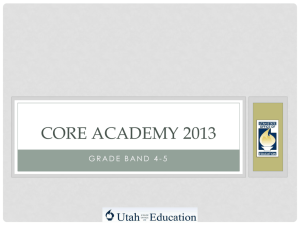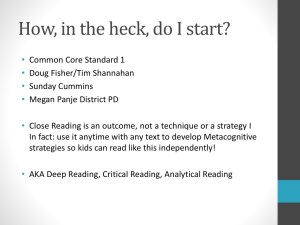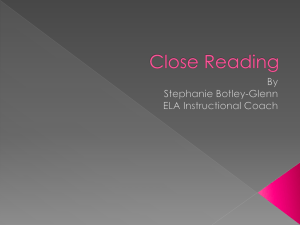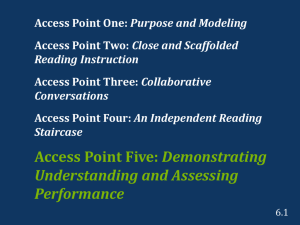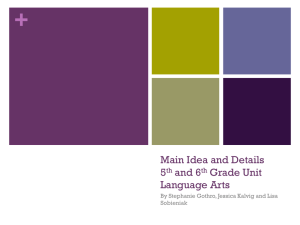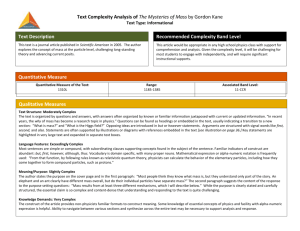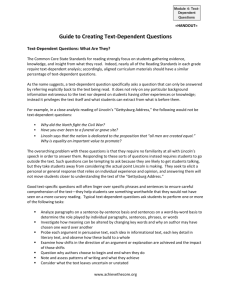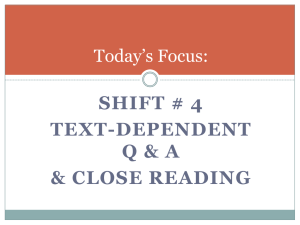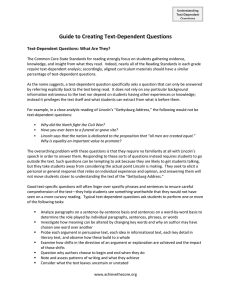Text Dependent Questions
advertisement
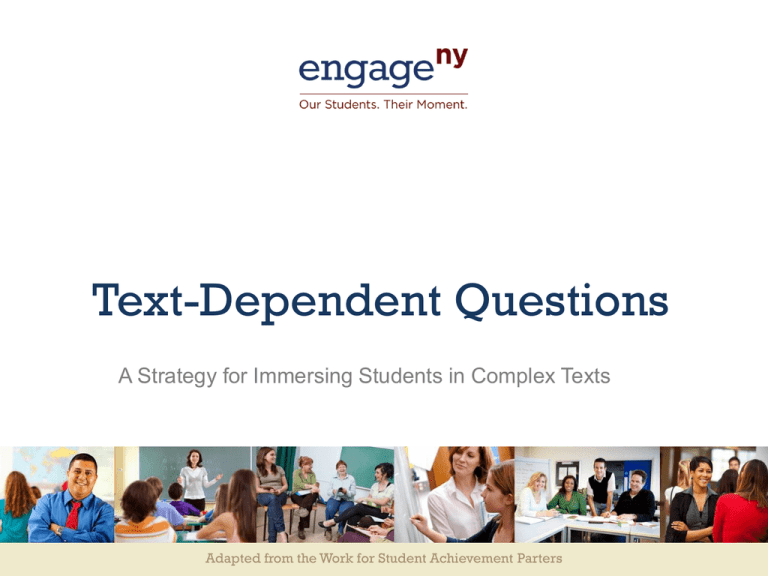
Text-Dependent Questions A Strategy for Immersing Students in Complex Texts Adapted from the Work for Student Achievement Parters Let’s Work from a Set (10 minutes) • Open the Odell Education materials to a set of lessons – these are the lesson plans that will help you implement/help others implement the kind of lessons we’ve been doing together. • Read one or two lessons and collect the text-dependent questions that are suggested in the lessons. • Examine them as a set – what do you NOTICE about these questions? Based on the Work of Student Achievement Partners 2 Text-Dependent Questions... • • Can only be answered with evidence from the text. • Focus on words, sentences, and paragraphs, as well as larger ideas, themes, or events. • Focus on difficult portions of text in order to enhance reading proficiency. Can be literal (checking for understanding) but must also involve analysis, synthesis, evaluation. Based on the Work of Student Achievement Partners 3 Text-Dependent Questions are not… ONLY low-level, literal, or recall questions (a few though, help students feel early success). Focused on comprehension strategies Just questions… Based on the Work of Student Achievement Partners 4 Non-Examples and Examples Not Text-Dependent Text-Dependent In “Casey at the Bat,” Casey strikes out. Describe a time when you failed at something. What makes Casey’s experiences at bat humorous? In “Letter from a Birmingham Jail,” Dr. King discusses nonviolent protest. Discuss, in writing, a time when you wanted to fight against something that you felt was unfair. What can you infer from King’s letter about the letter that he received? In “The Gettysburg Address” Lincoln says the nation is dedicated to the proposition that all men are created equal. Why is equality an important value to promote? “The Gettysburg Address” mentions the year 1776. According to Lincoln’s speech, why is this year significant to the events described in the speech? www.engageNY.org 5 Three Types of Text-Dependent Questions When you're writing or reviewing a set of questions, consider the following three categories: • Questions that help students grapple with themes and central ideas • • Questions that build knowledge of vocabulary Questions that build knowledge of syntax and structure Based on the Work of Student Achievement Partners 6 Creating Text-Dependent Questions from Scratch Step One: Identify the core understandings and key ideas of the text. Step Two: Start small to build confidence. Step Three: Target vocabulary and text structure. Step Four: Tackle tough sections head-on. Step Five: Create coherent sequences of text-dependent questions. Based on the Work of Student Achievement Partners 7 Core Understanding and Key Ideas • Reverse-engineered or backwardsdesigned • Crucial for creating an overarching set of successful questions • Critical for creating an appropriate culminating assignment Based on the Work of Student Achievement Partners 8 Vocabulary Which words should be taught? • Essential to understanding text • Likely to appear in future reading Which words should get more time and attention? • More abstract words (as opposed to concrete words) • persist vs. checkpoint • noticed vs. accident • Words which are part of semantic word family • secure, securely, security, secured Based on the Work of Student Achievement Partners 9 Syntax and Text Dependent Questions • Syntax can predict student performance as much as vocabulary does. • Questions and tasks addressing syntax are powerful. Example: Who are the members of the wolf pack? How many wolves are in the pack? To answer this, pay close attention to the use of commas and semi-colons in the last paragraph on pg. 377. The semi-colons separate or list each member in the pack. Based on the Work of Student Achievement Partners 10 Structure and Text-Dependent Questions Text-dependent questions can be crafted to point students’ attention to features of text that enhance understanding (such as how section headers and captions lead to greater clarity or provide hints regarding what is most important in informational text, or how illustrations add to a narrative). Based on the Work of Student Achievement Partners 11 Structure and Text Dependent Questions Examples: • “Look at the illustrations on page 31. Why did the illustrator include details like the power outlets in the walls?” • “Dillard is careful to place opposing descriptions of the natural and man-made side-by-side. How does this juxtaposition fit with or challenge what we have already read? Why might she have chosen this point in the text for these descriptions?” Based on the Work of Student Achievement Partners 12 Try It (20 minutes) • Write good questions for or for something from the Odell Education materials that are in the binder Step One: Identify the core understandings and key ideas of the text. Step Two: Start small to build confidence. Step Three: Target vocabulary and text structure. Step Four: Tackle tough sections head-on. Step Five: Create coherent sequences of text-dependent questions. Based on the Work of Student Achievement Partners 13 Feedback from Colleague (10 mins) • Trade work with a partner. • • • • Praise – how did your partner use specific information from research used to support claims about the importance of complex text, close reading, or developing evidence-based claims in students’ college and career readiness? What else did your partner do well? Question – what are you wondering about? Suggest – what one or two suggestions might you make to help your partner do his or her best work? Based on the Work of Student Achievement Partners 14
